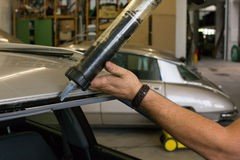Glass Sealant
Glass sealant applications may never have crossed your mind, but using adhesives on windshields is one of the oldest known uses of adhesives in the automotive industry. What started out as a substance that keeps the windshields in place, now does so much more. Windshield adhesive is among the oldest bonding applications known to the automotive industry.
- Glass adhesive hold the windshield properly in place and offer support and stability to the vehicle.
- In the unfortunate event of a crash the windshield remains firm improving the safety of the passengers.
- The windshield doesn’t detach from the frame of the vehicle under most circumstances.
- Windshield adhesives must endure changing weather and retain their flexibility at all times.
Types of windshield adhesives
Windshields were bonded by using polyurethane or silicone in the earlier times before new-age windshield sealants were put in use. However, those glueing and sealing techniques soon became out of fashion. With the new technological advancements, smarter adhesives made of silyl modified polymers and modified silane polymers came up. They offer much more than just sealing. They can be used for more than only cars where the requirement is only for bonding and sealing. These adhesives also find themselves used in larger vehicles like buses and agricultural machinery.
Silyl modified polymer windshield bonding adhesive
These grade of sealants come in either one or two-component systems. Silyl modified polymer adhesives do not contain harmful components like isocyanates, halogens or silicones. This technological innovation brings its VOC down to almost zero.
Along with their fast curing properties, the need for a primer to start bonding. Combining all these factors together, we see that using a silyl modified polymer adhesive brings down the overall cost of surface preparation. It also saves on the time required.
Modified silane polymer windscreen bonding adhesive
Modified silane polymer adhesives are yet another considerably good option. They bond significantly well with wood, plastic, metal and other composite materials. They are also known as MS Polymers. Majorly recommended when the adhesive is put through a wide variety of climates. It fulfills the requirement to remain flexible.
They are formulated to benefit from the properties of materials such as acrylates, silicone, urethanes and butyl rubber. This makes them suitable for use in windsceen adhesives.They are also easy to apply and have fast curing systems just like silyl modified polymer adhesives.
Polyurethane Windshield glass sealant
Polyurethane Windshield Adhesive is a component, moisture curing polyurethane based adhesive for direct glazing in Automotive Glass Replacement. Supex PU 75
PROPERTIES
- One component formulation
- Good non-sag properties
- Short cut-off string
- Cold application
- Fast curing – Rapid strength development
- High mechanical performance
- High Modulus
- High initial bond strength
- Can be overpainted
TYPICAL TECHNICAL PROPERTIES BEFORE CURING
 How to replace a windshield with Supex glass sealant
How to replace a windshield with Supex glass sealant
One of the most common and dangerous mistakes that people make while replacing a windshield is using the wrong type of adhesive. There are several materials like bathtub caulking or silicone which should be avoided completely. Currently, the products that are used to produce adhesives for windshields are Polyurethane, Silicon, Modified silicon, Butyrl and Acrylic. It is important to utilize strong adhesives and sealants to hold windshield glass in place.
It is important to understand the difference between adhesives and sealants. Adhesives are used to bind two different bodies together and sealants fill gaps and prevent the entry of water. There are a few differences between Urethane (adhesive) and Silicone (sealant) which include:
- Urethane is 90 times stronger than silicone.
- Unlike urethane, has better prolongation and it gets softened by high temperature & humidity.
The few advantages of urethane are:-
In case of an accident or a collision, urethane prevents the windshield from coming off its frame. It also prevents the roof from caving in, when the car rolls over. For long-term durability, car makers use urethane adhesive to bond the windshield to the frame of the car. Adhesives are exposed to cold, heat, humidity, rain and salt air for years to verify long-term strength.
During windshield replacement, the right balance between the viscosity and thixotropy of the adhesives should be ensured. It should be made sure that these urethane adhesives should not leave little trails over the windshield. Professionals should be contacted for the use of accurate adhesives.
How do you use auto glass adhesive on a windshield?
- Apply the adhesive to the OEM urethane film on the pinch weld or directly to the glass.
- Position the glass by aligning the masking tape on the glass and car body.
- Press the windshield glass in place to ensure that it comes in complete contact with the adhesive.
- Your windshield is fixed.
How do you remove a windscreen bonded with auto glass adhesive?
Feed it through the bond from inside the car on an angle using small, long nosed pliars until there is enough poking out to pull with pliars. Take your time, keep handles flat to the glass with one man inside & one out & you should be fine.
How long does it take for auto glass adhesive to cure?
For the urethane to be fully cured, it can take anywhere between 48 to 72 hours, but after 24 hours it will be stuck securely in place.
How do I know if my windshield is installed properly?
- Water Leaks Around the Edges. …
- You Hear a Whooshing Sound at High Speed. …
- The Glass Looks Wavy. …
- It’s Not Flush with the Car’s Frame. …
- You Hear Rattling Noises. …
- The Old Adhesive Is Still There.
